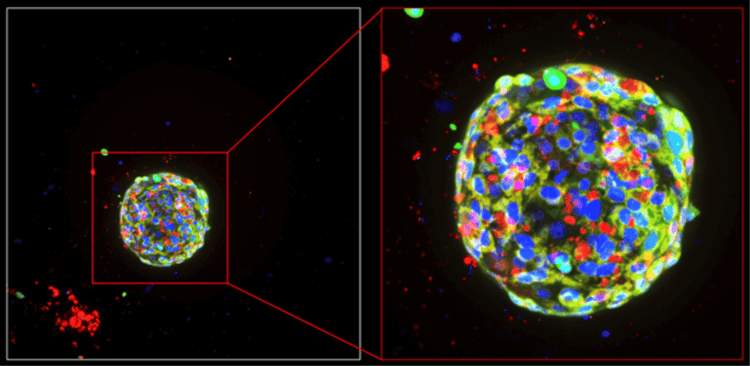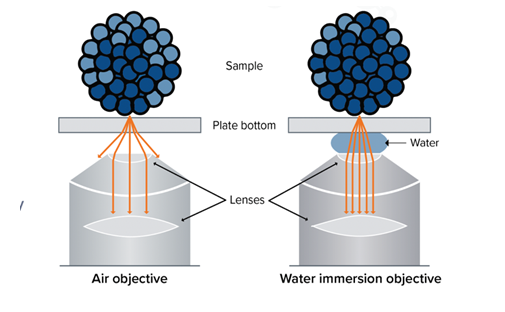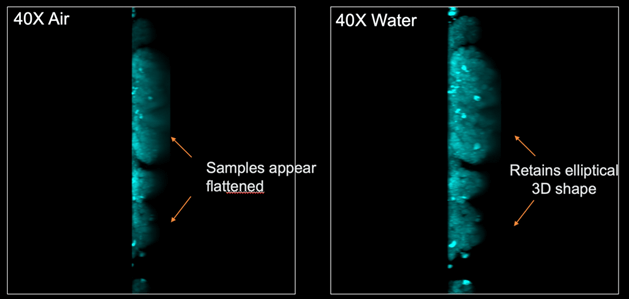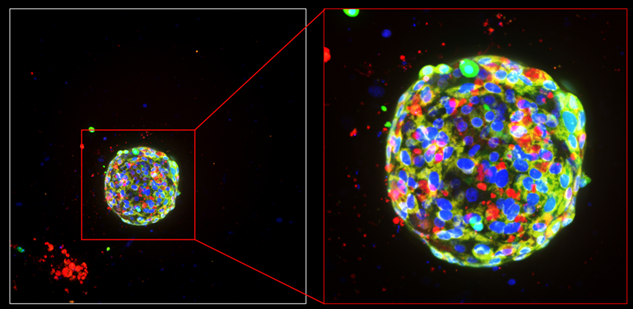
Water immersion technology and high-content imaging: A closer look
Three-dimensional (3D) cellular assays have emerged as a valuable tool in drug discovery and biological research, as they closely mimic in vivo environments and are shown to generate more physiologically relevant data than many 2D assays. With the increased utilization of 3D cultures for phenotypic screening and toxicity assessment, there is a growing need to optimize assay sensitivity, resolution, and throughput.
Here, we explore how high-performance water immersion objectives on the ImageXpress® Micro Confocal High-Content Imaging System facilitate these growing demands by enhancing the sensitivity, resolution and throughput for complex 3D structures such as spheroids, organoids, and organ-on-a-chip biology.

What is water immersion technology?
In terms of high-content imaging, water immersion technology automatically and consistently places a layer of water between the objective (magnification) and the sample.
Many cellular imaging systems are designed to have air between the objective and the sample. When using air objectives for 3D imaging, a significant portion of the fluorescent light that is emitted from a sample is refracted away from the objective and becomes lost. This reduces the signal that is collected from the sample, and causes the sample to appear distorted. Oil objectives have been the gold standard for 3D confocal imaging, because they collect more light from the sample, which increases the signal intensity and enhances the image resolution. However, oil objectives are still problematic, as oil can be difficult to handle in an automated fashion and these objectives can also cause some distortion when imaging large 3D samples.

Achieve greater sensitivity and resolution without sacrificing speed
Compared to air objectives, water immersion objectives have a higher numerical aperture, allowing them to collect more light from the sample. This increases image intensities by up to four times and minimizes distortion, providing a more accurate representation of the sample shape. In simple terms, cells exist in water. By placing water between the objective and the sample, you are better able to match the cellular environment and produce a higher quality image.

Water immersion objectives also take a much finer z-slice of a 3D image in comparison to dry objectives (higher NA). And because of the increased light collection, they produce sharper, crisper images with finer cellular detail.

20X Water Immersion Objective
Confocal 42 μm pinhole spinning disk
Maximum Projection of 21 z-planes at 5 μm steps (100 μm)
Because the water immersion objective collects a higher signal from the sample, you are able to decrease your exposure time and thus increase the speed of the acquisition. Alternately, you may choose to maintain a higher exposure time and acquire even brighter images.
Gain deeper insight into thicker 3D samples
The ImageXpress Micro Confocal system includes a Deep Tissue confocal disk module and laser illumination options that can be combined with water immersion objectives to help you image even deeper into 3D samples. The thicker the sample, the more likely you are to experience pinhole crosstalk, contamination that is produced by the surrounding light, which results in haze and reduced image quality. The Deep Tissue confocal disk module is designed to minimize the crosstalk between pinholes and remove haze so that you can image deeper into the sample.
How water immersion works on the ImageXpress Micro Confocal system
The technology consists of two bottles, a diaphragm pump, and an adapter for the objective. The pump sends pressure into the source bottle and pushes water to the objective. As the imaging occurs, water rolls off the objective and gets pulled back through via the vacuum created by the pump. MetaXpress® software automatically refills the water within milliseconds, as needed, for a seamless experience.
The water immersion objectives are field upgradeable and can be easily implemented with minimal changes to an existing workflow. When you first turn on the system, or transition from an air objective to a water objective, it takes only a few minutes for the water to move onto the objective so that imaging can begin.
Sensors are built into the water controller system to detect faults (e.g., leaks) and monitor system health. The system is designed to automatically supply and maintain water to the objective, making the setup and operation seamless for the user. The software also provides user-friendly alerts when it is time to refill the bottles, which typically need to be refilled once a week, depending on the types of samples that are being run.
Don’t overlook your 2D samples
When considering water immersion objectives for high-content imaging, your 2D samples should not be overlooked. Water immersion objectives can also be very useful for 2D imaging, especially if you need to examine fine features, such as cytoskeletal filaments. If you have an assay in which the fluorescence is very weak, water immersion can be used to help boost the signal as much as possible.
You also have the ability to decrease your exposure time with 2D samples, which will allow you to image your plate faster.
Learn more about how water immersion objectives work with the ImageXpress Micro Confocal system, and also view Tim Baranowski’s Innovation Showcase presentation from this year’s ISSCR Virtual conference.